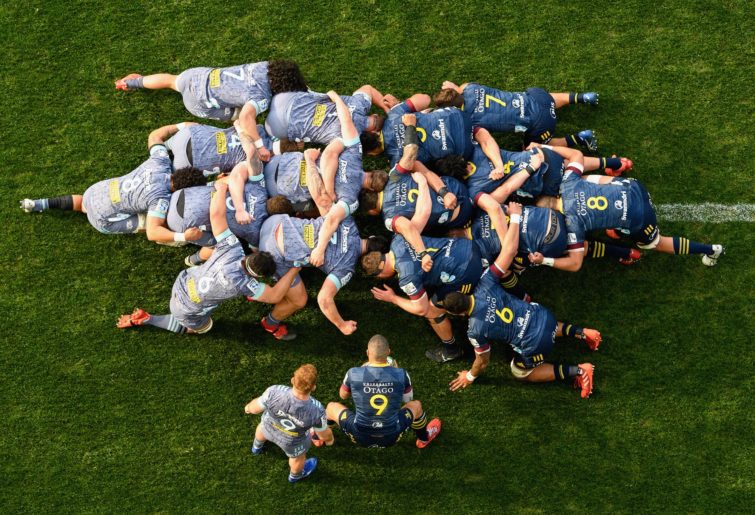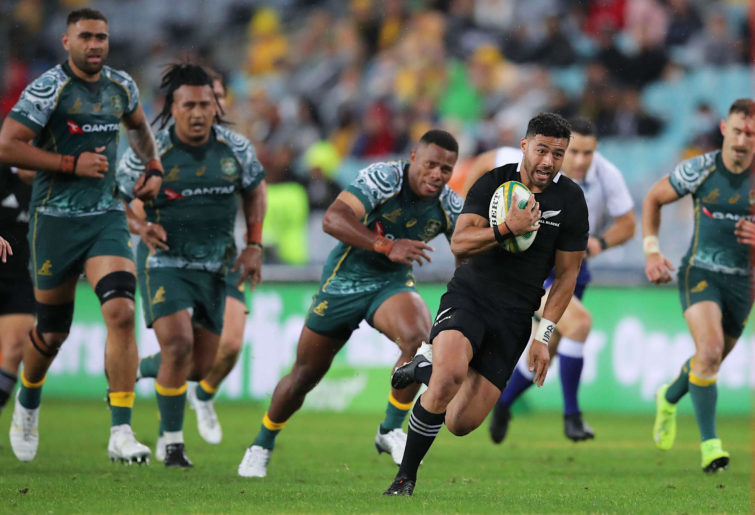Timing, as they say, is everything. Rugby union got its World Cup out of the way in late 2019, and World Rugby and Japan banked the financial and emotional spoils from what was a hugely successful tournament.
But with the COIVD-19 pandemic now into its second year, sport continues to compromise significant extremes. Japan’s Olympic Games is limping along like Monty Python’s black knight, games chief Yoshiro Mori seemingly too preoccupied with women who “talk too much” to notice the health, logistical and public opinion elephants crowding his and the IOC’s boardroom.
Major international competitions soldier on, most with compromised conditions and lopsided schedules due to cancelled fixtures and almost all without one of the things that makes sport what it is: the fans.
Australian and New Zealand’s isolation and relatively low case loads enabled franchise and Test rugby to be played last year, and – fingers crossed – the prognosis for 2021 also appears promising.
But elsewhere, in Japan and Europe in particular, the obstacles have been far greater, with the jewel in 2021’s crown, the Lions tour of South Africa, under serious threat. Australia’s offer to step in as host is a potentially great solution, but even so, that would not be the same thing as having thousands of Lions supporters descend on the republic.

(Michael Dodge/Getty Images)
This environment of uncertainty has highlighted the plight of professional and amateur rugby players, many of them denied their regular physical and social fix and, with respect to the leading players, their anticipated incomes.
Throw in ongoing issues about crowded playing schedules, COVID compliance and the ever-increasing uncertainty around the effects of concussion injury and there are myriad obstacles being thrown in the path of players.
In this context player advocacy and representation has never been so important.
One irony is that the effects of the pandemic and concussion apply equally to rugby’s professional and amateur cohorts. In that sense these two arms of the game, divergent since the advent of professionalism, have never been so closely linked.
Because rugby is a team sport falling under the jurisdiction of various world and national administrations and with players contracted to a mix national bodies and individual clubs operating within a tenuous financial model, it is unthinkable to imagine individual players ever having the ‘hand’ to adequately represent themselves.
The two key players in this part of the world are New Zealand Rugby Players Association (NZRPA) CEO Rob Nichol and Australia Rugby Union Players Association (RUPA) chairman Justin Harrison.
Nichol, competing this weekend in New Zealand’s annual Coast to Coast endurance event in partnership with Richie McCaw, is a long-time player advocate and current board member and foundation head of the International Rugby Players Association in 2001. He has been at the forefront of initiatives such as ensuring players receive a greater share of World Cup revenue and working on various World Rugby subcommittees to try to bring about a more equitable and workable global season.
Introducing the premise that there is too much rugby being played and trained, I put it to him that years of talks preceded a 2017 adjustment to the June touring window only for it to be met with underwhelming indifference and by contempt by England’s Rugby Football Union, who immediately saw it as an opportunity to extend their season.
Given that COVID-19 was an opportunity to re-set but that another attempt last year to broker a new structure failed, I queried whether we are ever likely to see the introduction of a workable global calendar or not.
Nichol’s informed view is that a better-defined Test season (likely July to November) is closer than ever, albeit with a COVID-caveat that has forced stakeholders into ‘survival mode’ for now.
“The key is to settle first on a window and only then focus on populating that window, coordinating all of the aspirations and traditions,” he says.
“It’s obviously not easy, but there is no doubt that progress has been made and that some of the organisations involved are having deeper conversations and understand things better from a player’s perspective.”

(Photo by Kai Schwoerer/Getty Images)
From an Australian point of view “anything that reduces the travel demands on players is welcome,” says Harrison. But in recognition of the status quo and the tortuous process in effecting change, Harrison also points to a timely change in emphasis.
“Looking back to 1996 and the Australian Institute of Sport, we were probably at the forefront of how we addressed high performance. In more recent times there’s been a growing emphasis on mental fatigue, so that’s something we’re continuing to work forward on in terms of calibrating our player development programs.
What about the impending entry of private equity investment into rugby? Does this have the potential to place even greater demands on players through the need to provide even more content?
Nichol and Harrison both acknowledge the risk attached to any new party entering an environment for the first time but both are cautiously optimistic. The announcement last week providing clarity around Silver Lake’s proposed US$465 million investment into New Zealand Rugby being compartmentalised into commercial rights would seem to support the idea that such investments are – for now at least – able to be kept at arm’s length from the rugby environment.
“If such partnerships are approached correctly,” Harrison says, “and there’s due recognition of what has been built, expectations are made clear, and there is an enduring respect for the fact that we’re dealing with human athletes, then it’s likely that the positives will outweigh the negatives.”

Richie Mo’unga. (Photo by Matt King/Getty Images)
Discussion shifts to the apparent conflicting demands on players who on one hand are subject to welfare impositions and compromises due to the amount of rugby involvement but on the other hand seek to maximise their earnings potential during what can be a relatively short playing window.
How do player representatives adequately represent players’ best interests in both respects?
Harrison acknowledges the challenge and points out that individual decisions by players still need to be made.
One interesting example is Rebels and Wallabies lock Matt Philip, who at the completion of the 2020 season in December, having played in all six Wallabies Test matches, taking on a senior role and despite having only had three previous caps as a replacement, departed for a six-month long stint with French club Pau. This followed a trying Super Rugby season during which Philip was confined to the Rebels’ Central Coast hub.
Philip is expected to return to Australia to be available for Wallabies selection in the latter part of 2021. Expectation will be high for him to kick on from 2020’s performances, but with almost two years constant rugby and rugby training under his belt, there can be no guarantee of continuing improvement.
Speaking in general, Harrison says: “We all have an interest to see that players don’t feel the need to play at all costs. Some of that comes down to our education processes, knowing that we can’t match the remuneration on offer in some of these overseas markets.

(Jono Searle/Getty Images)
“We try to make sure that players know exactly what they’re stepping into when leaving a well-regimented system like we have here and accept contracts in some environments and regimes where the arrangements might not be as well governed from their perspective.”
To the same question Nichol offers an interesting perspective, maintaining that ‘player welfare’ and ‘financial objectives’ are not mutually exclusive.
“How do you define welfare?” he asks. “Financial security is a very important part of wellbeing and welfare, and these things aren’t necessarily a trade-off.”
What is apparent is that gains made by both player organisations have largely come about through the adoption of a collaborative and constructive approach to dealing with the national unions.
This contrasts with how other player groups around the world hold less sway in environments where the owner-administration model is different.
If that sounds like the re-emergence of the old chestnut of the failing of the national unions in the UK and France to sign players to central contracts in 1995, representing the scourge of rugby, it is.
It also suggests that what works for Australia and New Zealand might not necessarily be the right approach to adopt in those locations where the employers come from a different perspective.
Incredibly, Premiership Rugby recently floated the prospect of extending their season by another month to accommodate the admission of Saracens and Ealing Trailfinders into its top division. Why demand a player to commit to an eight-month-long season when you can make him to commit to nine?
Both men describe how players are not only employees, they are also ‘the product’. If that product continues to be compromised due to greed and suffocating, blinkered ownership, it may be the case that a different, more assertive approach is warranted in those markets.
Meanwhile, what loomed during 2020 as a potential flashpoint between players and Rugby Australia over cessation of the temporary collective bargaining agreement put in place due to the effects of COVID-19 has been turned into a positive.
The relationship between RUPA and Rugby Australia has improved under the new administration, and Friday’s announcement – which will see the leading professional playing group make permanent salary concessions, helping to maintain the viability of other programs and recognising the reality of Rugby Australia’s reduced revenue streams – is a welcome and sensible outcome.
Coming just two days after a breezy, enthusiastic launch by new broadcaster Stan/Nine and a fortnight from the kick-off of the 2021 Australian season, the timing of this announcement could not have been better.
































































































